The Martha Graham Dance Company commissions works by Annie-B Parson, Pontus Lidberg, and Sidi Larbi Cherkaoui.
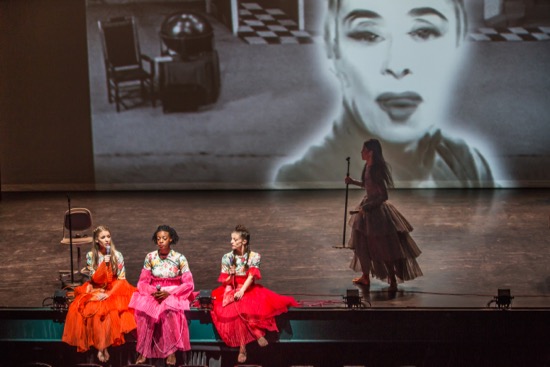
Members of the Martha Graham Dance Company in Annie-B Parson’s I used to love you. (L to R): Anne O’Donnell, Leslie Andrea Williams, Laurel Dalley Smith, and Xin Ying. Onscreen: Martha Graham as Jocasta and the set for her Punch and the Judy. Photo: Brigid Pierce.
There’s no point in wondering how Martha Graham would react to her seeing her company onstage today (Rant and rave? Smile approvingly? Wade in and make changes?). She disowned many of the 191 dances that she choreographed during her creative lifetime (1926-1991); others were forgotten; others changed slightly in their details over the years. Today, the Martha Graham Dance Company under artistic director Janet Eilber and executive director LaRue Allen thrives by balancing Graham’s masterpieces (those preserved on silent film or video or handed down by former company members) with commissioning works by contemporary choreographers.
The company’s current season at the Joyce Theater is titled “Sacred and Profane,” and one program that I saw was preceded by a film of that name created by former Graham Company member Peter Sparling. In it, images of Graham in her great 1931 Primitive Mysteries swim through those of an unfurling golden blossom (perhaps a night-blooming cereus) and multiple ones of the back of a naked seated dancer. Figuring out what’s sacred and what’s profane in what occurs onstage is not always simple (or desirable, given that your sacred may be my profane and vice versa).
The company is offering two world premieres during its two-week Joyce season: I used to love you by Annie-B Parson (her second work for the company), and Mosaic by Sidi Larbi Cherkaoui. Pontus Lidberg’s Woodland is new to New York, although his work is familiar (New York City Ballet premiered his The Shimmering Asphalt just this past January). Of the three works, I used to love you is the most complex and the most audacious—both in terms of its subject and the ways in which it challenges the performers. Parson has reassembled characters and bits of choreography from Graham’s satirical 1941 Punch and the Judy (a clip from a 1940s silent film of it has been playing while the audience enters the theater). Furthermore, the ingenious video by Jeff Larson that plays on a medium-sized, home-movie screen whirls and fragments images of that cast, amid advisory titles and intermittent blips, squiggles, and other effects. Tei Blow’s music emphasizes the strange connections between past history and present innovation.
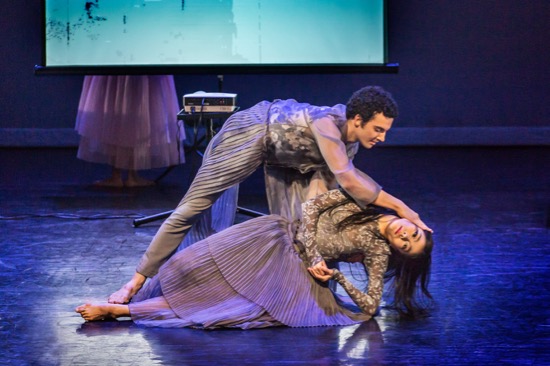
Lorenzo Pagano and Xin Ying in Annie-B Parson’s I used to love you. Photo: Brigid Pierce.
That screen gets furled and re-opened periodically (Wait! Who was kissing whom behind it when it’s first rolled down? Uh-oh. . . .). In the original Punch and the Judy, Erick Hawkins and Graham (lovers at the time) squabbled; Merce Cunningham appeared as “Pegasus,” perhaps symbolizing her winged imaginings; and three ladylike Fates bustled about, posed around a chair, and spoke about this very odd version of the well-known puppet play that makes a joke of domestic violence. Parson’s voluble trio (Anne O’Donnell, Leslie Andrea Williams, and Laurel Dalley Smith—all wonderful) sit at the front of the stage a lot of the time, wearing remarkable frou-frou dresses by Oana Botez and wielding microphones with cords that match their outfits. But their chairs have wheels, and they can fly around the stage like broomless witches. Their words (text by Will Eno) can be down-to-earth informative and discreetly bitchy, as when they discuss “family troubles.” As in Punch and the Judy, there’s a bed onstage (well, a cot with a mattress) for Lorenzo Pagano to laze on when he’s not being macho and slapping Xin Ying around or depositing a kiss or a pat on the seated women. Unlike Graham, Ying (just once) grabs a mic and talks angrily at us in one of China’s languages.
Parson has given Pagano some of the big, swaggering, leg-swinging moves that Graham created for Hawkins, and So Young An duplicates part of a solo performed by the pair’s daughter in the original silent film (Nina Fonaroff); it’s an extremely funny take on puppet-like stiffness and awkwardness, and she looks far too big a girl to sit on her mother’s knee, which she does, with her father patting her head, until the trio of women collapses the tender family picture. Near the end of I Used to Love You, tiny multiple images of Fonaroff in the daughter role dance all over the screen.
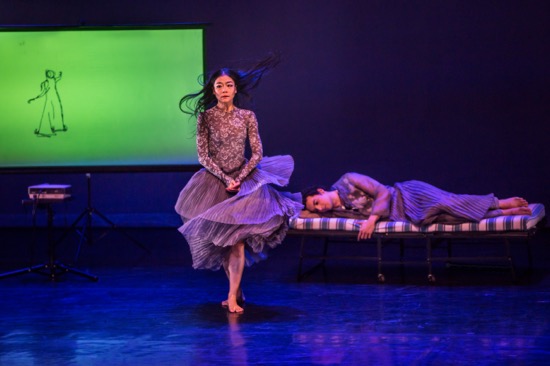
Annie-B Parson’s I used to love you. Xin Ying getting riled up. Lorenzo Pagano napping. Photo: Brigid Pierce
When Cunningham-as-Pegasus might make an entry, he doesn’t. No, no, we’re told in projected words, no we can’t see that. However Ben Schultz enters, and he and Pagano, sitting on the upstage bed, remove their shirts, and after a couple of suggestive poses, lie stiffly side-by-side, while doomy music sounds, and Ying’s face appears in close-up on the screen and vibrates. The “Fates,” who have been dozing, wake up, and lines like “she must have known!” can be heard. They also mention her hurt feelings, That’s putting it mildly. Ying goes crazy, whipping and throwing around one of the men’s discarded tee-shirts. Graham’s Judy, as a small figure in the film, looks as if she were trying to make sense of Punch’s peccadilloes; Ying looks as if she has murder on her mind, and the three women sit on the floor and pull their bright-colored skirts over their heads while she rages. A huge projected, barren globe moves closer and closer and sinks below the stage. Finally she collapses, and everyone hovers around her; Schultz feels her pulse. A close-up of Graham as Jocasta (another enraged wife) in her Night Journey ripples onto the screen, and the three women tells us that Nick Hung’s lighting will “gently fade.” Instead, it can’t wait to bring on the darkness. Sacred? Profane? You tell me. Either way, vastly entertaining.
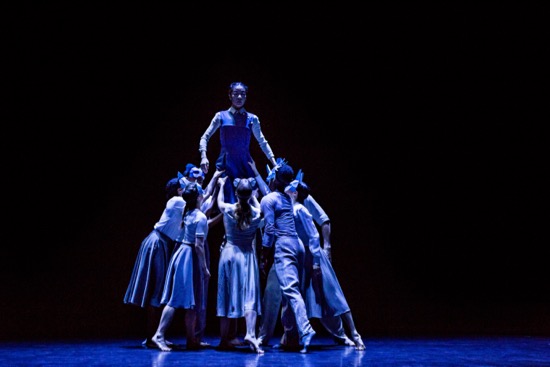
Xin Ying and the cast of Pontus Lidberg’s Woodland. Photo: Brigid Pierce
The marvelous Ying also has a leading role in Lidberg’s Woodland, and what a very strange land it is. To Irving Fine’s Notturno for Strings and Harp, the nine dancers accumulate gradually until that they can dance in unison; then, when they rush across the stage in a line stretching from the front to the of the stage, back, she drops out of it. This must be a ritual of some kind, because all eight return to the stage wearing elegant horned masks (by Wincroft Designs). They stare at her; she seems to be trying to help them in some way, or figure out what they want. She could also be a sacrificial victim. Removing the masks, they cluster around her, lift her. They also dance in pairs, and in one of the most striking images, each man falls to the floor, and lifts one flexed foot to face the ceiling; his partner, kneeling beside him, places her cheek against its sole. In the end, they again form that line close to the side of the stage, but this time they don’t rush across, the lights just go out. Are they preparing to dislodge another member from their ranks?
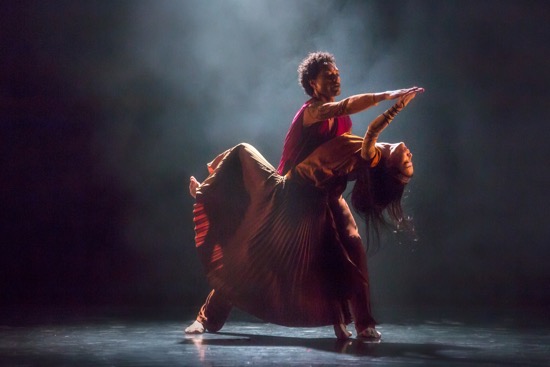
Abdiel Jacobsen and Xin Ying in Sidi Larbi Cherkaoui’s Mosaic. Photo: Brigid Pierce.
Cherkaoui’s Mosaic, which premiered at the second-night Gala, starts out with a vivid image. Nine dancers are clustered in a tableau, some standing, some kneeling or sitting. Their lips are moving, and there are voices in the score. Their arms branch out, wrists flexed. This is a design they will return to twice more— their hands sometimes trembling; the last time, they shake themselves so violently that, if this were a mosaic, tiles would be falling out of it. In fact, each time they cluster, a dancer does just that. The first, Anne Souder, performs a remarkable solo, beginning by moving her hips sinuously and turning a slow somersault. She stays close to the floor for a while, her limbs almost prehensile as they reach out. This, too, may be part of some sort of ceremony; she and Lorenzo Pagano embrace before she leaves the stage.
The ambiance is Middle Eastern (Cherkaoui is Belgian and Moroccan); the publicity notes that he drew on Sufi mysticism for Mosaic. Smoke drifts up in a corner, and occasionally Hung’s lighting turns red. Three banks of overhead blue lights descend one by one. The music is credited to Felix Buxton, but we also hear voices singing the ancient Shabbat poem, Yedid Nefesh. Initially, the five women in the cast of nine wear long, finely pleated skirts that move with wonderful fluidity; their hair hangs loose. The men and women jump and spin, but they also move sensuously, their hips swaying, their hands twisting around each other. In a solo, Pagano strokes his own body, and in the last part of Mosaic, the women remove their tops and skirts onstage, and the men take off their tops, revealing tight-fitting, translucent garments that make them appear tattooed; costumed like this, they form traditional male-female partnerships.
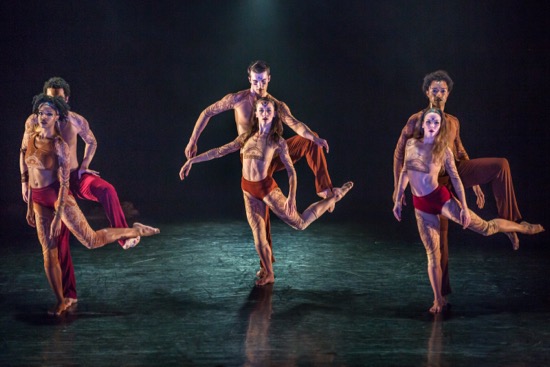
Sidi Larbi Cherkaoui’s Mosaic: (L to R) Leslie Andrea Williams and Lorenzo Pagano, Anne Souder and Lloyd Mayor, Anne O’Donnell and Abdiel Jacobsen Photo: Brigid Pierce.
I have admired several pieces of Cherkaoui’s very much—Babel (words), for instance, Orbo Novo, Sutra, and a duet he created with Akram Khan. I understand his plan to structure this piece as a collection of mosaic tiles, But there’s something confused about Mosaic, and it is disappointingly organized in terms of space. After a while, it begins to seem as if dancers enter, arrange themselves nicely spaced out, facing us, dance the same steps more or less in unison, and leave the stage, with no apparent goal beyond ceding it to a trio or a sextet. For me, the atmosphere that began so fascinatingly eventually dissipated, despite the wonderfully alert and impassioned dancers: Abdiel Jacobsen, Charlotte Landreau, Lloyd Mayor, Ari Mayzick, O’Donnell, Pagano, Souder, Williams, and Ying.
Over the course of two evenings at the Joyce, I saw seven dances. Having now written almost 1500 words about everything but Graham’s own works, I will fold my tent and write about those in a separate post.

This is wonderful writing Deborah and I hope “I used to love you” is on the program when the Graham company comes to Portland later in the spring.
Just came back from the second of two evenings at the Joyce with the Graham Company and, as always, loved your takes on the three new works. What a company Janet has helped build! Did want to say, though, that I noted, in Larbi’s MOSAIC, quite a lot of take-off of ‘orientalism’ cf the hand gestures and pleated Bharatanatyam fan-like skirts, as well as the forehead dots and other religious marks on foreheads, that were definitely ‘a l’indienne’. The undulations clearly referred to ‘raks-al-sharai’ (‘belly dance’) but the whole was about a way of “looking’ at the east – in which Larbi included India.
I’m grateful to Rajika Puri for weighing in about a possible link to Indian dance in “Mosaic.” I missed seeing those forehead dots!